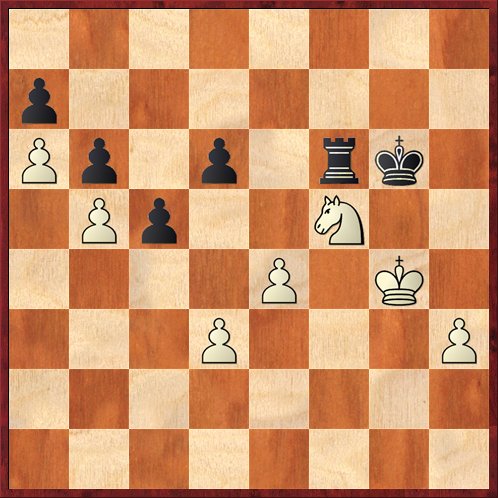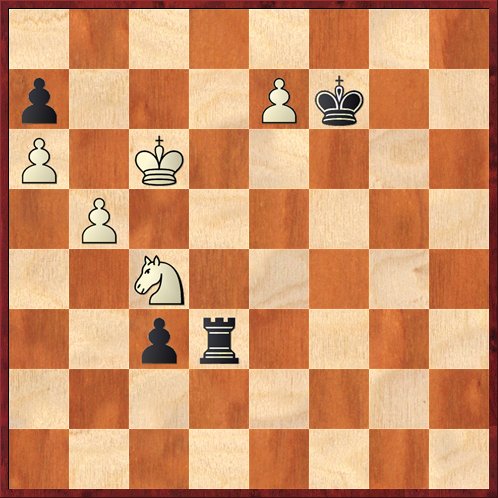The U.S. Chess League started its eighth season this week, and for the first time I watched online at chess.com. (Thanks to Gjon Feinstein for tipping me off to the fact that the games were being streamed there.) I mostly followed the San Francisco – Carolina match, in which the San Francisco Mechanics were heavy rating favorites but had to scramble just to pull out a 2-2 tie.
The crucial matchup turned out to be on board 2, where GM Jesse Kraai had Black against FM Kassa Korley. It was a must-win for the Mechanics, who were now trailing 1-2. Korley made a bad choice to put his bishop on g6, and they arrived at the following position:
FEN: 8/4r1p1/5pBp/2k2P2/3p4/1Pn2KP1/3R1P2/8 w – – 0 1
Korley played 1. Bh7, understandably trying to get his bishop back into play via g8. But he ran afoul of the marauding knight! Jesse slammed down the move 1. … Ne4! There’s a hidden threat here that Korley didn’t see, and he played 2. Rd3??, allowing Jesse to play 2. … Ng5+ forking the king and bishop. White resigned.
Of course White had to play 2. Rc2+. You might enjoy trying to work out the win for Black. (According to Rybka, the correct reply is 2. … Kb6!, whose main virtue is that it doesn’t get in the way and doesn’t walk into possible checks like Rc4+ and Bc4+.) However, the main thing I want to talk about is how the game DID finish. Why did White walk into this knight fork?
There’s one other key fact I haven’t told you, which is that White only had a minute left on his clock. That’s not quite as bad as it sounds, because the USCL games are played with a 30-second time increment — but it nevertheless means that White was under considerable time pressure.
I think that what this example shows is that even for strong masters — Korley is in the high 2300s — knight moves are a little bit tricky. It just isn’t immediately obvious that a king on f3 and a bishop on h7 are in a forkable position. If Korley had had more time and been under less pressure, of course he would have seen it. But when you are harried and only have a few seconds to move, knight forks are the first thing that you start to overlook.
I think this observation has practical significance. If you find yourself playing against a knight when you’re in a time scramble, you should make a mental note to consciously check for knight forks before you move. You can’t just go by intuition. You have to deliberately look for them.
Here’s another example that was extremely fresh in my mind, because it happened in my last-round game this weekend against Praveen Narayanan! We reached the following position in a time scramble. I have 9 minutes left for the game and he has 4 minutes. I’m playing Black.
FEN: 8/p7/Pp1p1rk1/1Pp2N2/4P1K1/3P3P/8/8 b – – 0 53
I don’t know whether Black should be winning in this position, but I doubt it. However, during the game I thought I was winning, and I played 53. … d5??
Of course, what I missed was the knight fork, 54. Ne7+! Here is where I played 54. … Kh6 and offered a draw, which my opponent declined. Then Narayanan played 55. Nxd5?, which was possibly a mistake. It allowed me to activate my rook with 55. … Rf1. I think he should have played 55. ed instead. But in a time scramble, who can tell?
Anyway, after a few more moves the knight once again rose from the dead, like a zombie. Here’s the position:
FEN: 8/p3Pk2/P1K5/1P6/2N5/2pr4/8/8 b – – 0 64
The clocks now show 30 seconds or so for White to 1:30 for Black. White has just moved his knight from b6 to c4, a seemingly innocent move that merely gets the knight out of the way of the b-pawn. But Black just pushes his pawn to c2 and queens first, right?
WRONG!! In fact, 64. … c2??? would have been a blunder for the ages, as it lets White fork the king and rook AND win the rook AND defend the c-pawn, with 65. Ne5+ Kxd7 66. Nxd3.
Believe it or not, I actually started moving my hand to push the c-pawn, but something held me back at the last moment. I think that it was the memory of the earlier knight fork, just 10 moves ago, that made me say, “Hold it, can he play a fork here?” In a strange and miraculous way, my earlier blunder prepared me subconsciously to avoid a much worse blunder here.
I withdrew my hand, took a deep breath and played 64. … Ke7! instead. Narayanan then played 65. b6? c2 66. b7 c1Q 67. b8Q Qxc4+ and White resigned. Whew!
Actually, he could have still made matters tricky for me with 65. Na3! but that’s a subject for another time.
There’s an old saying, “Knights on the rim are dim.” I would like to add a new one: “Knights in time trouble are worth double.”






{ 4 comments… read them below or add one }
Well I should just have accepted that draw offer! It’s almost as though the draw offer cast a spell or something, so that by declining it I took it upon myself to lose. That being said, I don’t imagine that would be easy to win that endgame even with tons of time. It’s so much more difficult to shift from glacial time scale thinking (as was the case for most of that difficult game) to making quick and dirty moves, and the blunders demonstrated that :). But before black played d5(??!!) white was actually considering (or pre-empting mentally) d5 with exd5 and the rook/K should be chained to guarding it forever. This was somehow forgotten. Taking with the knight let the monster out, so to speak (which had hitherto been kept under lock and key by the minors), and it could play havoc by devouring pawns all over the place. I think, by the way, that it’s easier to find forks when you are the side owning the knight, as a corollary to saying that it’s easier not being able to see the forks when the opponent owns them; sort of like “heads you lose, tails I win”.
I like your blog.but can you give the complete score of the game before arriving that positions?so as to study the opening connected to middle and endgame..i have a request to analyze 1.c3?! First move for white.it sound funny but i like to explore new opening lines..i use this line to surprise my oppenet.can you give your ideas about it.thanks in advance.more power.and nice changes in your new web page.you have photo now
In this case (the Kraai game) I didn’t have the complete game score. In general I agree with you — I like to look at the game as an organic whole. But in some specific cases I want to focus on a more limited part of the game, as in this entry where I really wanted to focus on the issue of why we overlook knight forks in time trouble and what to do about it. It seemed to me that giving the whole game would distract from my message.
Some people have suggested in the past that I should attach a PGN for people to download, but what I’ve found is that the mechanics of doing this takes me an extra 5 minutes and it’s just too much of a headache. (By contrast, inserting the FEN for a diagram takes me only an extra one minute, and this seems to be worth it.)
Anyway, thanks for your message and I appreciate you comments on the new website! As for 1. c3, if I’m that desperate for variety I’ll play 1. a3 instead! 😎
Iam inspired by your “danas opening philosophy”.thats why i tried 1.c3…when i play white,then why not? Gm Nakamura play 1.e4..e5. 2.Qh4 lines,and now one of the strongest grandmaster..i knew your busy person.but if you have opportunity can you write about 1.c3 ..,?.i like the way you write and your insightful analysis,..i learn a lot..from your writing..